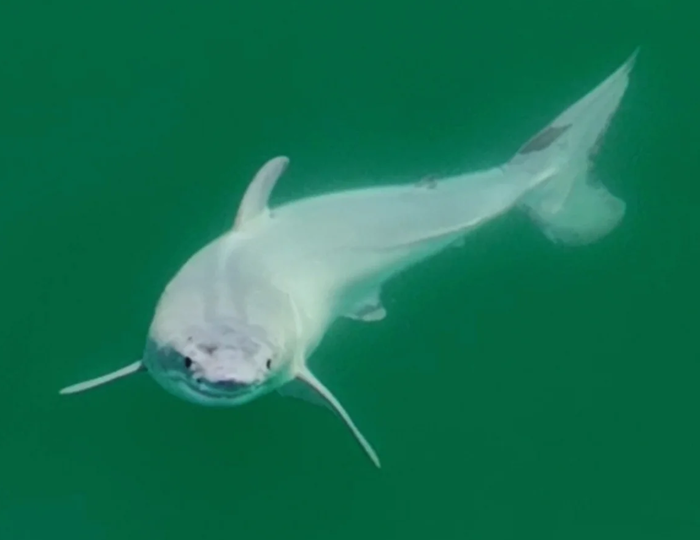Reviewed by Danielle Ellis, B.Sc.Jan 30 2024
It is hard to imagine great white sharks as newborns. Great whites are the largest predatory sharks in the world and have the highest death toll from attacks on people. This is partly because it appears, no one has seen one in the wild until recently.
 Front view of the great white shark Sternes and Gauna observed. Image Credit: Carlos Gauna/The Malibu Artist
Front view of the great white shark Sternes and Gauna observed. Image Credit: Carlos Gauna/The Malibu Artist
On July 9th, 2023, close to Santa Barbara on California's central coast, wildlife filmmaker Carlos Gauna and Doctorate Student Phillip Sternes of UC Riverside were scouting the seas for sharks. Something intriguing showed up in Gauna's drone camera's viewfinder that day. They had never seen a shark pup like this one before.
We enlarged the images, put them in slow motion, and realized the white layer was being shed from the body as it was swimming, and I believe it was a newborn white shark shedding its embryonic layer.”
Phillip C. Sternes, Department of Evolution and Organismal Biology, University of California, Riverside
A recent publication published in the journal Environmental Biology of Fishes details these discoveries. The relevance of having witnessed a live baby white shark is also discussed in the paper.
Gauna is known as The Malibu Artist. Millions of people have watched his films showing sharks swimming near beachgoers, which he has filmed thousands of hours throughout the world. The long-standing enigma surrounding great white birthing behaviors may be resolved by what he and Sternes saw.
Where white sharks give birth is one of the holy grails of shark science. No one has ever been able to pinpoint where they are born, nor has anyone seen a newborn baby shark alive and there have been dead white sharks found inside deceased pregnant mothers. But nothing like this.”
Carlos Gauna, Wildlife Filmmaker, Camarillo, United States of America
The authors of the study agree that it is possible the white coating the shark shed was caused by a skin ailment, but they do not think so.
Gauna said, “If that is what we saw, then that too is monumental because no such condition has ever been reported for these sharks.”
The two think that what they witnessed was, in fact, a baby great white shark for a variety of reasons.
First, live pups are born to great white females. The shark embryos may obtain their protein from unfertilized eggs while still in the womb. The moms exude a "milk" that provides the developing shark pups with extra nutrition.
Sternes said, “I believe what we saw was the baby shedding the intrauterine milk.”
Another factor contributing to this phenomenon is the existence of substantial great white sharks, likely pregnant, in this area. Gauna had witnessed their presence in this location in preceding years and during the weeks leading up to the current
Gauna explained, “I filmed three very large sharks that appeared pregnant at this specific location in the days prior. On this day, one of them dove down, and not long afterward, this fully white shark appears, it is not a stretch to deduce where the baby came from.”
Thirdly, the shark's dimensions and form are similarly suggestive of a baby. The two saw that it was slender, short, and spherical. Sternes said, “In my opinion, this one was likely hours, maybe one day old at most.”
Lastly, it has long been suggested that great white sharks give birth here off the coast of central California.
There are a lot of hypothetical areas, but despite intense interest in these sharks, no one’s seen a birth or a newborn pup in the wild, this may well be the first evidence we have of a pup in the wild, making this a definitive birthing location.”
Phillip C. Sternes, Department of Evolution and Organismal Biology, University of California, Riverside
Many academics think that great white sharks are born further out to sea. Given its age, the fact that this dog was seen on camera about a thousand feet or less from the shoreline makes it noteworthy that it was most likely born in shallow waters.
Internationally, great white sharks are classified as endangered.
Sternes concluded, “Further research is needed to confirm these waters are indeed a great white breeding ground. But if it does, we would want lawmakers to step in and protect these waters to help white sharks keep thriving.”
Source:
Journal reference:
Gauna, C., et.al., (2024). Novel aerial observations of a possible newborn white shark (Carcharodon carcharias) in Southern California. Environmental Biology of Fishes. doi.org/10.1007/s10641-024-01512-7